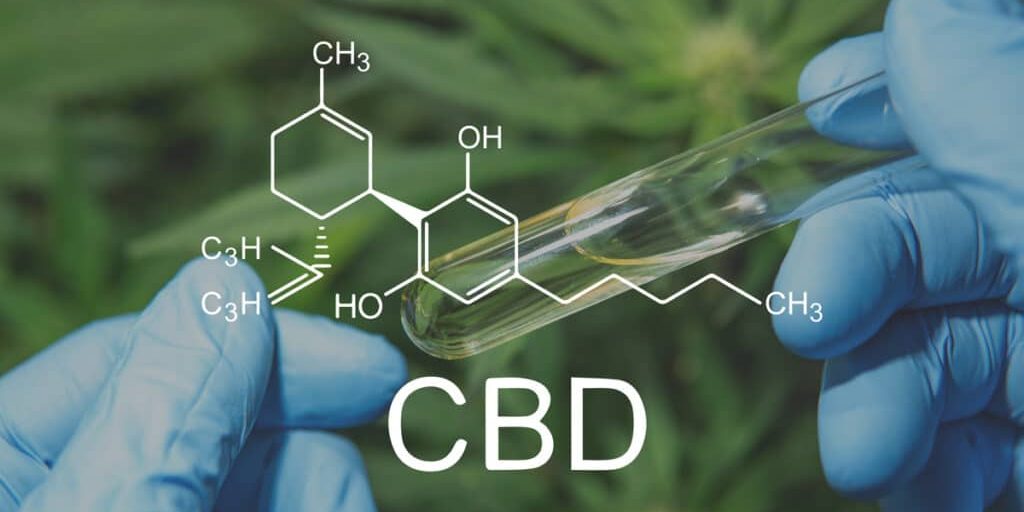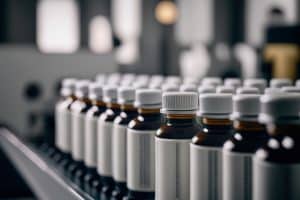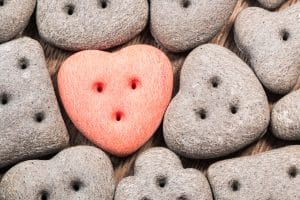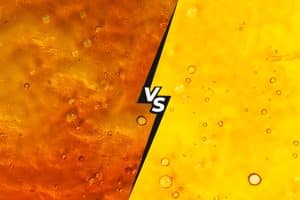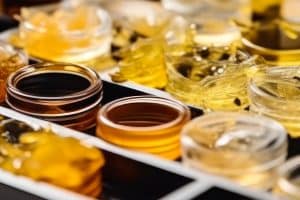CBD Dosage Chart
First things first: Always start low and go slow when you are beginning CBD. But don’t be afraid to go all the way!
CBD is a very forgiving natural medicine that leaves plenty of room for you to experiment safely. The process of gradually increasing and moderating your CBD intake until you find the most effective daily dose is called titration. This process may take just a few days to a couple of weeks depending on your individual response to CBD.
You are unique, and your CBD dose will be, too. How much CBD you take will vary based on a number of factors, including how much you weigh, your individual tolerance level, as well as how you take your CBD (e.g., vape, sublingual, oral, or topical application). Let’s focus on body weight momentarily and get to the last two factors later in this CBD dosage guide.
Use the CBD dosage chart below to choose your initial starting dose by your current body weight. It is the primary factor first-time users should base their beginning dose upon before titrating subsequent CBD dosages over the coming days. The following CBD dosage chart is for educational purposes only. It is not meant to be medical advice. Your individual needs may differ from what is recommended, and you should adjust how much CBD you take accordingly. Only you know how much CBD is helping you to feel better.
I’m A First-Time User: How Do I Start Taking CBD?
Welcome to the wonderful world of CBD! We think you’ll love it here and are happy you joined us.
We’ve carefully crafted this quick start guide to set you up for success. We will answer a few of the most common questions first-time CBD users ask, such as how much CBD should I take, which CBD blend should I try, and what is the best way to take CBD.
How much CBD should I take?
This is always a tricky question to ask because there are two predominant schools of thought in the CBD world. Some experts contend that microdosing is superior to dosing CBD by body weight and vice versa.
We’ve based our sound judgment on the science, and it is simply this: more clinical research exists showing the benefit of weight-based CBD administration than for microdosing. But we won’t knock microdosing because that method also works for some CBD users!
Here are the primary differences between the two ways to take CBD (feel free to give either one a try):
- CBD microdosing
Involves taking very small doses of CBD many times throughout the day. The lowest effective dose of 25 mg CBD to up to 50 mg CBD is recommended per 24-hour period. Divide the dose you choose by ten. As an example, you will take ten 2.5 mg to 5 mg doses about every hour to equal the recommended minimum effective daily CBD dose. CBD effects from microdosing are extremely subtle. - Body weight-based CBD dosing
Recommends taking a certain amount of CBD per pound of body weight one to four times daily for best results. CBD effects are much more pronounced using the weight-based dosing method. Refer to the CBD dosage chart above to calculate the right dose for you.
The truth is whichever method works best for you is the right way for you to take CBD. Many first-time users begin by taking the minimum effective 25 mg CBD dose and increasing it over time depending on how it makes them feel. Weight-based dosing provides an extra level of personal customization that’s more convenient than microdosing, and it’s also backed by scientific research.
Which type of CBD should I try?
CBD breaks down into three major types called full spectrum, broad spectrum, and pure isolate.
Clinical research shows varying levels of effectiveness depending on which CBD type you take, so it’s important to choose the right CBD for you.
Use the chart below to quickly compare the types of CBD and how they differ from each other:
CBD Comparison Chart: Full Spectrum / Broad Spectrum / Pure CBD Isolate |
|||
|---|---|---|---|
| Full Spectrum CBD | Broad Spectrum CBD | Pure CBD Isolate | |
| Contains CBD | Yes | Yes | Yes |
| Minor Cannabinoids (CBN, CBG, CBC) |
Yes | Yes | No |
| Terpenes | Yes | Yes | No |
| Flavonoids | Yes | Yes | No |
| THC | Yes (less than 0.3%) |
THC-Free (0.0%) |
THC-Free (0.00%) |
| Aroma | Natural Hemp | Natural Hemp | Odorless |
| Taste | Natural Hemp | Natural Hemp | Flavorless |
| Color | Gold / Amber | Gold / Amber | Clear |
| Base Extract | Full Spectrum Distillate | Broad Spectrum Distillate | Pure Isolate Powder |
| CBD Oil Tincture | Full Spectrum CBD Oil | Broad Spectrum CBD Oil | CBD Isolate Oil |
| CBD Softgels | Full Spectrum CBD Softgels | Broad Spectrum CBD Softgels | - |
- Full Spectrum CBD Oil offers the richest and most robust cannabinoid profile that’s loaded with terpenes and flavonoids to boot! In addition to the active ingredient Cannabidiol (CBD), full spectrum extracts also contain other major and minor cannabinoids like Cannabinol (CBN), Cannabigerol (CBG), and Cannabichromene (CBC). Full spectrum CBD contains detectable levels of the psychoactive cannabinoid THC. But don’t worry — the amounts of THC are legally compliant and so minuscule that you will never get high, even if you take a hefty CBD dose regularly.
- Broad Spectrum CBD Oil is virtually identical to full spectrum with just one key difference. There are no detectable levels of THC in broad spectrum extracts (0.0% THC). Many first-time users choose broad spectrum CBD because they want to avoid THC altogether. That’s perfectly fine. Broad spectrum CBD offers a rich cannabinoid, terpene, and flavonoid profile, too. The benefits you experience taking broad spectrum CBD will be almost indistinguishable from its full spectrum counterpart.
- CBD Isolate Oil formulas are single-molecule products. They contain no other cannabinoids, terpenes, or flavonoids whatsoever. Isolate CBD oil is ideal for people who are averse to the full-flavored taste of full spectrum and broad spectrum extracts. We also recommend CBD oil isolate if you want to avoid THC altogether. CBD oil isolate is typically so pure that it tests at 0.00% THC by volume — a truly THC-free product.
What is the best way to take CBD?
How you take your CBD determines how quickly your body will respond and how long CBD will stay in your system.
Some delivery methods have a higher bioavailability than others, albeit a shorter action period. Bioavailability means how much of the CBD you take will actually get used by your body. The shorter the action period of your preferred delivery method, the more often you may need to dose CBD.
Let’s explore the four most common delivery methods for CBD in the chart below. Each one has its pros and cons. Especially notice the differences in how fast and how long the various delivery methods work. Pick the one you think will work best for you.
Individual Differences of CBD Products |
||||
|---|---|---|---|---|
| How you take it | Bioavailability | Absorption | Peak Effects | How long it lasts |
| Vaping Inhale |
31% - 56% | Less than a minute | 10 minutes or less | About two hours |
| Oral Swallow |
5% - 19% | Within an hour | One to two hours | Up to eight hours |
| Sublingual Hold 30 seconds under tongue |
13% - 19% | Within an hour | One to two hours | Up to six hours |
| Topical Apply to target areas |
5% | Within an hour | One to two hours | Up to six hours |
| Rectal CBD suppository |
5% | Within an hour | One to two hours | Up to six hours |
You should take CBD regularly (i.e., at least once daily) no matter the CBD delivery method you choose, because it allows for the buildup of CBD serum levels in your blood. Regular use will maximize the therapeutic benefits of CBD in the near term and improve your overall results in the long term.
Step By Step Guide To Finding The Perfect CBD Dose
So, how do you find the perfect CBD dose? Easy! Use the following dosage calculation formula or check out our CBD dosage chart at the top of this article to find the right CBD dose for you based on your body weight.
The dosage calculation guide below will answer a few of the most common questions first-time users ask when beginning CBD, such as how do I calculate the optimal CBD dosage, how do I choose the right CBD formula, and can I change my CBD dose frequently before I find the amount that works best for me.
Step 1: How do I calculate the optimal dosage
We discussed microdosing and weight-based dosing above in the section titled how much CBD do I take?
To summarize, microdosing involves taking tiny doses of CBD many times during the day. You will typically divide the dose you choose (e.g., the minimum effective dose of 25 mg CBD) into ten micro doses taken about every hour. The research on microdosing is scant at best and body-weight dosing is recommended due to the wealth of clinical research that supports its effectiveness.
CBD is a very forgiving natural medicine. Its excellent safety profile leaves plenty of wiggle room for you to experiment safely while you find the optimal dose. The process of gradually increasing and moderating your CBD intake until you find the most effective daily dose is called titration. It may take just a few days up to a couple of weeks to titrate depending on your individual response to CBD.
Our CBD dosage chart at the top of this article is recommended to calculate your weight-based dose unless you are in between the listed weight classes and want an amount more specific to your exact weight. Then you should use the following dosage formula to calculate the optimal CBD dose by plugging in your exact weight and preferred strength:
[TOTAL WEIGHT] x [STRENGTH OF DOSE] = RECOMMENDED AMOUNT OF MILLIGRAMS OF CBD PER DOSE
The following chart provides the CBD dosage recommendations for mild strength, average strength, and maximum strength in kilograms (kg) or pounds (lbs):
Chart: CBD Dosage By Pound or Kilogram |
|||
|---|---|---|---|
| Single Unit Weight Metric | Mild Strength Dose | Average Stength Dose | Maximum Stength Dose |
| 1 lbs U.S. Imperial Pound |
0.25 mg / lbs | 0.5 mg / lbs | 1.5 mg / lbs |
| 1 kg Metric Kilogram |
0.55 mg / kg | 1.1 mg / kg | 3.3 mg / kg |
Here is how you would use the dosage formula to calculate the CBD dose for someone who weighs 100lbs:
Example #1:
Weight: 100 lbs.
Dosage Strength Preference: Average Dose
Optimal Dose Calculation: [100 lbs] x [0.5 mg] = 50 mg of CBD Recommended Per Dose
Here is another example for a person weighing 200lbs:
Example #2:
Weight: 200 lbs.
Dosage Strength Preference: Average Dose
Optimal Dose Calculation: [200 lbs] x [0.5 mg] = 100 mg of CBD Recommended Per Dose
Substitute your current body weight and your preferred CBD dosage strength (i.e., average, mild, or maximum strength) to find the perfect CBD dose for you.
Step 2: Finding the right CBD strength for you
You’ve figured out the perfect CBD dose for you based on your body weight. It’s now time to choose the best CBD formula strength to meet your needs.
What is the one thing all CBD products have in common, be it oil tinctures, softgels, gummies, baked goods, concentrates, isolate powders, topicals, or vapes? They contain CBD of course!
The first thing you must do is figure out how much CBD is in the product you plan to take. CBD products display various numbers on the label, such as “750 mg,” “3,000 mg,” “12,000 mg,” et cetera. These numbers tell you the strength of your CBD product and account for how much CBD is in it calculated in milligrams (mg). You divide the strength of your CBD product by the number of servings in it to determine the potency of each dose you take.
Here is an example of how you would determine the potency of a 1 mL dose of Cannabiva 12,000 mg Full Spectrum CBD Oil using our potency calculation formula:
[TOTAL CBD IN THE BOTTLE] / [TOTAL MILLILITERS IN THE BOTTLE] = AMOUNT OF CBD PER DOSE
Example #1:
Cannabiva 12,000MG Full Spectrum CBD Oil (30 mL bottle)
[12,0000] / [30] = 400 mg of CBD per dose
In the next example, we will determine the potency of a 1 mL dose of Zero High 10,000 mg Pure CBD Isolate Oil:
Example #2:
Zero High 10,000MG Pure CBD Isolate Oil (30 mL bottle)
[10,000] / [30] = 333 mg of CBD per dose
Apply our dose potency formula to any product for which you know the total amount of CBD along with the exact amount of servings in the package. Not sure how many servings your CBD product has in it? Check the “Nutrition Facts” panel on the product label to find the serving size and number of servings.
You can also try a free CBD sample of our 25mg CBD oil-infused softgel capsules for easy dosing to see how it works for you.
Step 3: Adjust your dosage based on how your body responds
You now know the optimal CBD dose you should take and how to measure the correct amount of CBD using our potency calculation formula.
The last step is to take your first dose and begin titration (i.e., the process of gradually increasing and moderating your CBD intake until you find the most effective daily dose). Only you know how much CBD is helping you to feel better, so it’s important to pay careful attention to how you feel before, during, and after each CBD dose until you find the right amount for you.
CBD has an impeccable safety profile. It’s also a very forgiving natural medicine that leaves you quite a bit of wiggle room to experiment safely while you find the optimal dose. CBD is not psychoactive and will never cause you to feel euphoric or “high” after taking it, even if you take more than the recommended CBD dosage.
Side effects are extremely rare when you take CBD as directed. Clinical trials typically use CBD dosages that range from 25 mg up to as much as 1,200 mg or more depending on the study and specific wellness concerns being scientifically researched. Reported side effects (less than 0.5% chance of occurrence) are often similar to placebo and may include dry mouth, increased thirst, appetite increase or decrease, stomach upset, or drowsiness. Allergic reactions are not commonly reported when taking CBD, but you should talk to your doctor if you are unsure.
Finding the right bottle of CBD oil
We discussed the three main CBD product types for first-time users and calculated the perfect CBD dose step-by-step in our guide above. Finding the right bottle of CBD oil will be a breeze.
Remember that the numbers displayed on your CBD product label calculate its total strength in milligrams (mg). Scroll through the following reference chart to review the most common CBD product strength concentrations. We break down the total strength per bottle into 1 mL dosage strengths and single drop dosage strengths.
CBD Chart: Common CBD Oil Product Potency and Dosage Amounts |
||
|---|---|---|
| Total CBD In Bottle (30 mL / 1 oz) |
CBD Per Dose (1 mL dropper) |
CBD Per Drop (30 drops per mL) |
| 100 MG | 3.33 mg | 0.11 mg |
| 250 MG | 8.33 mg | 0.27 mg |
| 500 MG | 16.67 mg | 0.56 mg |
| 750 MG | 25 mg | 0.83 mg |
| 1000 MG | 33.33 mg | 1.11 mg |
| 1500 MG | 50 mg | 1.67 mg |
| 2500 MG | 83.33 mg | 2.78 mg |
| 3000 MG | 100 mg | 3.33 mg |
| 5000 MG | 166.67 mg | 5.56 mg |
| 6000 MG | 200 mg | 6.67 mg |
| 10000 MG | 333 mg | 11.1 mg |
| 12000 MG | 400 mg | 13.33 mg |
(*Important Note: Dropper openings may vary slightly due to manufacturing variables. The number of drops per milliliter dose may range from 25 – 40 per dropperful. We’ve used 30 drops per milliliter to make the calculations in this chart.)
CBD Safety Profile
CBD maintains an impeccable safety profile that’s backed by scores of research studies, clinical trials, and toxicity investigations.
Adverse reactions are extremely rare when taking CBD as directed. There is less than a 0.5% chance that you will experience any side effects after taking CBD. These may include dry mouth, increased thirst, appetite increase or decrease, stomach upset, or drowsiness. You should check with your doctor before taking CBD if you have a history of food sensitivity or if you’ve experienced an allergic reaction to any prescription drug or over-the-counter medication.
CBD Dosage Information
You are unique, and your CBD dose will be, too. How much CBD you take will vary based on how much you currently weigh, your individual tolerance to CBD, as well as how you take your CBD (e.g., vape, sublingual, oral, or topical application).
Here are some other key considerations to make in addition to the weight-based recommendations we provide in our CBD dosage chart at the beginning of this article.
CBD clinical trials and dosage strengths
CBD clinical research is ongoing with many different types of wellness concerns currently being explored by scientists.
Dosage amounts in CBD clinical trials vary considerably depending on the type of wellness concerns being studied. CBD dosage ranges in clinical trials range from 25 mg up to 1,200 mg per single dose. Average CBD dosages in research trials are between 300 mg to 600 mg CBD taken once or more times daily.
The duration of CBD clinical trials also differs significantly. Some CBD clinical trial participants have reported benefits or displayed positive results in study metrics after just one high-potency dose while others saw benefits over a period of multiple days or weeks of use.
CBD toxicity investigations show that it is a very forgiving natural medicine. In some cases, clinical trial participants ingested up to 35 times the recommended CBD dose based on their body weight with only mild to moderate side effects reported.
RELATED: Can I overdose on CBD? How much is too much to take?
You should not take more than the recommended CBD dose for your body weight unless you have adequate supervision by a qualified medical professional.
When should I take CBD?
You may take CBD in the morning, afternoon, evening, or before bed — anytime you feel the need for another dose. Wait between four to six hours between doses unless you are microdosing CBD.
Your CBD dosage schedule will be unique to you based on factors including your individual tolerance to CBD and the type of wellness concerns for which you are taking it.
First-time CBD users should always start low and go slow, especially when taking high-potency products with more than 3,000 mg CBD per bottle. The process of gradually increasing and moderating your CBD intake until you find the most effective daily dose is called titration. You may need to titrate for a few days to up to two weeks, depending on your individual response to CBD.
Take note that full spectrum CBD products contain very small amounts of THC. While not psychoactive in such minuscule doses, THC may still cause pronounced effects in hypersensitive users. Exercise basic precautions during the initial stages of titrating, such as using caution before working with heavy machinery, driving a car, or performing strenuous activities.
How often should I take CBD?
On average, CBD lasts between four to six hours per dose. You should take CBD regularly (i.e., at least once daily) because it allows for the buildup of CBD serum levels in your blood. Regular use will maximize the therapeutic benefits of CBD in the near term and improve your overall results in the long term.
How long CBD stays in your system depends on multiple factors that include how much you take, your diet, metabolism, body weight, dosage frequency, individual tolerance level, as well as how you take your CBD (e.g., sublingual ingestion, oral ingestion, topical application, or vaping).
Reference the CBD Delivery Methods and Bioavailability Chart above if you need to determine bioavailability, absorption times, peak effects, and dissipation times for CBD. Knowing these key metrics will help you to better gauge when to take CBD and how much CBD you should take during each dosing interval based on your preferred CBD delivery method.
How much CBD is too much to take?
CBD is safe, non-toxic, and non-psychoactive when used as directed. It will never cause you to feel euphoric or “high” after taking it, even if you take more than the recommended CBD dosage. There have been no reports of CBD overdose attributed to taking excessive amounts of CBD.
Toxicity investigations show that CBD is a very forgiving natural medicine. In some clinical trials, participants ingested up to 35 times the recommended CBD dose based on their body weight with only mild to moderate side effects reported.
Recommended CBD dosages range from between 50 mg to 1,200 mg and are well-tolerated by healthy users with significant differences in body weight. You should not take more than the recommended CBD dose for your body weight unless you have adequate supervision by a qualified medical professional.
What are the side effects of CBD?
CBD is safe and generally well-tolerated by healthy adults. Side effects from taking CBD are very rare, temporary in nature, and normally reported as mild to moderate
Reported side effects (less than 0.5% chance of occurrence) are often similar to placebo and may include the following:
- Dry mouth
- Increased thirst
- Appetite increase or decrease
- Stomach upset
- Drowsiness
Allergic reactions are not commonly reported when taking CBD. You should check with your doctor if you have a history of allergies or a sensitivity to certain foods, medications, or other plant-derived medicines.
Can I take CBD with other cannabinoids like CBN and CBG?
Any high-quality full spectrum or broad spectrum CBD already has very small amounts of major and minor cannabinoids. Adding extra cannabinoids like Cannabinol (CBN), Cannabigerol (CBG), or Cannabichromene (CBC) may even boost the effectiveness of the CBD you are taking through a natural phenomenon called the entourage effect.
Review the CBN Dosage Chart and CBG Dosage Chart to learn how much of these cannabinoids you should take when combining them with CBD oil.
Can I take CBD with herbs, supplements, and other natural medicines?
CBD is not known to interact with other dietary supplements, so you may safely combine it with other herbs, vitamins, and minerals.
Consider adding natural medicines used for stress relief, mood balance, energy, and sleep difficulty to complement the benefits of your favorite CBD formula!
Make sure you check with your doctor before making any changes or additions to your wellness plan.
Can I take CBD with my prescription medication?
CBD is metabolized by the liver using the exact same enzyme many prescription drug treatments use, too. Taking CBD with other prescription medicines may interfere with their breakdown and absorption. This interaction may potentially reduce the effect of one or both medicines leading to a decrease in effectiveness over time.
You should always consult with your doctor before adding CBD to your wellness plan if you take any prescription medication or over-the-counter drugs.
Summary
It’s easy to figure out how much CBD to take by following a few sensible guidelines.
First and foremost, remember to start low and go slow when you are beginning CBD. But don’t be afraid to go all the way! CBD is not psychoactive and will never cause you to feel euphoric or “high” after taking it, even if you take more than the recommended CBD dosage.
Titration is the process of gradually increasing and moderating your CBD intake until you find the right dose for you. Titration may take just a few days to a couple of weeks depending on your individual response to CBD.
How much CBD you take will vary based on a number of factors, including how much you weigh, your individual tolerance level, as well as how you take your CBD (e.g., vape, sublingual, oral, or topical application). Body weight is the primary factor on which first-time users should base their beginning dose. Our CBD dosage chart at the top of this article is recommended to calculate the most effective dose for you.
It’s safe to take CBD in the morning, afternoon, evening, or before bed — anytime you feel the need for another dose. How long CBD stays in your system depends on multiple factors that include how much you take, your diet, metabolism, body weight, dosage frequency, individual tolerance level, as well as how you take your CBD (e.g., sublingual ingestion, oral ingestion, topical application, or vaping).
On average, CBD lasts between four to six hours per dose. You should take CBD regularly (i.e., at least once daily) because it allows for the buildup of CBD serum levels in your blood. Regular use will maximize the therapeutic benefits of CBD in the near term and improve your overall results in the long term.
Recommended CBD dosages range from between 50 mg to 1,200 mg and are well-tolerated by healthy users with significant differences in body weight. You should not take more than the recommended CBD dose for your body weight unless you have adequate supervision by a qualified medical professional.
Full spectrum and broad spectrum CBD contains very small amounts of major and minor cannabinoids. Adding extra cannabinoids from CBN oil and CBG oil can help to further boost the effectiveness of your CBD through a natural phenomenon called the entourage effect.
CBD maintains an excellent safety profile which leaves quite a bit of wiggle room for you to experiment safely while you find the optimal dose. Side effects when you take CBD as directed. Reported side effects (less than 0.5% chance of occurrence) are typically mild and similar to placebo. They may include dry mouth, thirst, appetite increase or decrease, stomach upset, and drowsiness. Allergic reactions are not commonly reported when taking CBD, but you should talk to your doctor if you are unsure.
You should always consult with your doctor before adding CBD to your wellness plan if you take any prescription medication or over-the-counter drugs.
Do you still have questions about how much CBD you should take? Get in touch with a Cannabiva CBD team member to get answers.



